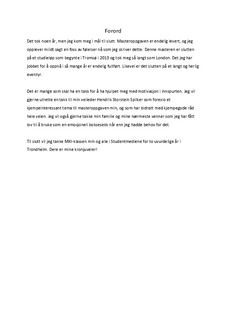| dc.contributor.advisor | Spilker, Hendrik | |
| dc.contributor.author | Johannessen, Magnus Kongshaug | |
| dc.date.accessioned | 2019-09-27T14:00:15Z | |
| dc.date.available | 2019-09-27T14:00:15Z | |
| dc.date.issued | 2019 | |
| dc.identifier.uri | http://hdl.handle.net/11250/2619189 | |
| dc.description.abstract | Denne masteroppgaven undersøker i hvor stor grad sendeflater, flyt og programleggingsteknikker har utviklet seg som resultat av den økte konvergensen, fragmenteringen og digitaliseringen av TV-tjenestene våre. Oppgaven benytter seg av en kvantitativ sendeflateanalyse av både lineær-TV og strømme-TV for å drøfte og analysere programleggingsteknikkene som brukes på bakgrunn av data samlet inn fra første halvdel av februar 2019. Dette gir oss innsikt i hvordan NRK og TV2s sendeflater har endret seg i overgangen til internettbaserte TV-plattformer.
Tradisjonelle programleggingsprinsipper overlever og blir modernisert i dagens TV-landskap, samtidig som nye blir introdusert. Prinsipper som horisontal og vertikal flyt har blitt utviklet og modernisert som følge av den økte bruken av strømmeplattformer. Både redaksjonell- og algoritmisk programlegging benyttes for å tilgjengeliggjøre programinnhold for seerne på både lineær-TV og strømmetjenester. Algoritmeføringer brukes aktivt av TV-husene for å tilgjengeliggjøre innhold for brukerne på strømmetjenestene deres. Vi ser en økt overgang fra produsentstyrt flyt hvor programleggerne har kontrollen over sendeflatene til en hverdag mer preget av brukerstyrt flyt hvor det er seerne som kontrollerer hva de vil se på.
Vi begynner å se utviklingen av nye TV-universer innad i kanalfamiliene hvor TV-kanalene og strømmetjenestene blir brukt til å utfylle hverandre. Fokuset har skiftet fra enkel lineær programlegging til programlegging på tvers av seerplattformer. I lys av denne utviklingen kommer en ny arbeidsdeling mellom plattformene til syne hvor lineær-TV begynner å bli mer «on-demand» mens strømme-TV begynner å bli mer «live». | |
| dc.description.abstract | This master thesis examines the extent to which transmitting surfaces, flow and programming techniques have evolved as a result of the increased convergence, fragmentation and digitization of our TV services. The thesis uses a quantitative analysis of both linear-TV and streaming-TV to discuss and analyze the programming techniques used on the basis of data collected from the first half of February 2019. This provides us with an overview of how NRK's and TV2's transmission surfaces have changed in the transition to Internet based TV-platforms.
Traditional programming principles survive and are modernized in today's television landscape, while new ones are being introduced. Principles such as horizontal and vertical flow have been developed and modernized as a result of the increased use of streaming services. Both editorial and algorithmic programming are used to make content available to viewers on both linear-TV and streaming services. Algorithmic affordances are actively used by the TV houses to make content available to users on their streaming services. We see an increased transition from manufactured flow where the programmers have control over the transmitting surfaces to an everyday life more characterized by user-controlled flow where it is the viewers who control what they want to look at.
We are beginning to see the development of new TV-universes within the channel families where the TV-channels and streaming services are used to complement each other. The focus has shifted from simple linear programming to programming across viewer platforms. In light of these developments, a new division of labor between the platforms emerges, where linear-TV is becoming more "on-demand" while streaming-TV is becoming more "live". | |
| dc.language | nob | |
| dc.publisher | NTNU | |
| dc.title | Digitaliseringen av TV-mediet - En kvantitativ analyse av NRK og TV2 sine programleggingsteknikker på lineær-TV og strømme-TV | |
| dc.type | Master thesis | |
